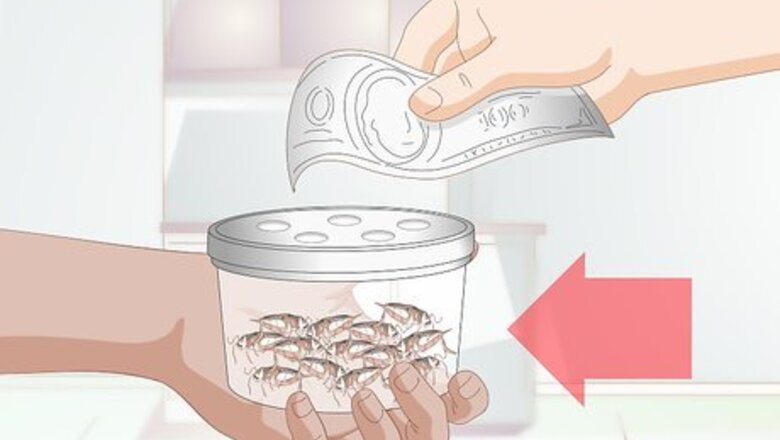
views
Keeping Live Feed

Buy live crickets. Crickets are the primary food given to chameleons in captivity. This is because crickets are easy to feed and breed. Chameleons also enjoy hunting crickets in their cage. You can find live crickets at a pet store or at a store that specializes in lizard and reptile care. These insects will probably not be fed, and you cannot feed your chameleon these straight from the pet store. They must first be gut loaded and dusted. Crickets should be no larger than the width of your chameleon's head. Baby chameleons can be fed every day. Chameleons up to three months old should be given as many small crickets as they can eat. Depending on the species, you can start feeding them every other day when your chameleon is between six and twelve months old. Most adult chameleons will eat between five and twelve crickets per feeding.
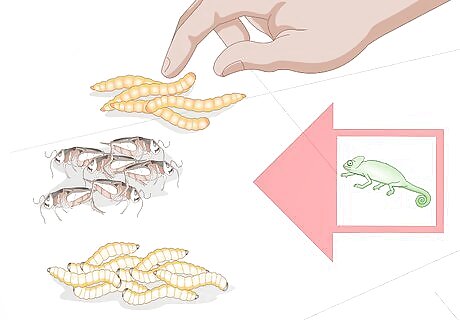
Vary the chameleon’s diet with other insects. While crickets will form the bulk of your chameleon’s diet, you can add other insects to the mix. These insects will be bought, raised, and gut loaded just like crickets. These other insects should serve as occasional treats to your chameleon to supplement their cricket diet. These include: Silk worms Mealworms Wax worms Flies Moths Cockroaches Locusts Hornworms Butterworms
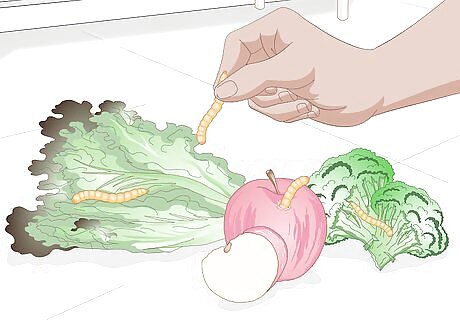
Gut load the insects. Gut loading is the process of feeding the insects certain foods to boost their nutrition value to chameleons. To properly gut load the food, you should feed them nutritious, high calcium foods a few hours before they are to be fed to the chameleon. Some good foods to use include: Leafy greens such as mustard greens, alfalfa, watercress, collard greens, and dandelion leaves Just make sure not to feed any type of lettuce because that's prevents his or her calcium to develop fully Sweet potato Carrots Oranges Mango Broccoli Apples
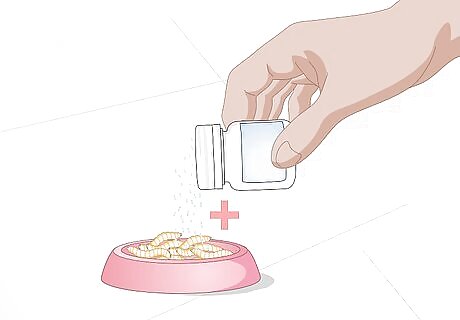
Dust the insects with vitamin supplements. It is important that your chameleon receives proper nutrients. You can boost their vitamin and calcium intake by coating the insects in special dust. This mineral and vitamin dust is specially formulated for lizards and can be found in most pet stores. Mist the crickets with water, and gently sprinkle the dust over the crickets. Do this immediately before feeding. For young chameleons, you will need to dust their food with calcium supplements two or three times a week. You can use a general multivitamin dust once every two weeks. Mature chameleons may only need their food dusted with calcium once a week. Chameleons are susceptible to Vitamin A deficiency. While gut loading insects with foods high in Vitamin A might be sufficient, you can also add a vitamin A supplement dust to the insects. A good calcium dust will contain twice as much calcium as phosphorus. Read the label to make sure that there is a good ratio. Dusting your chameleon's food with calcium will prevent it from getting MBD (Metabolic Bone Disease) Different brands have different ratios of vitamins. Always read the label to find the right dosage for your chameleon.
Providing Free-Range Food
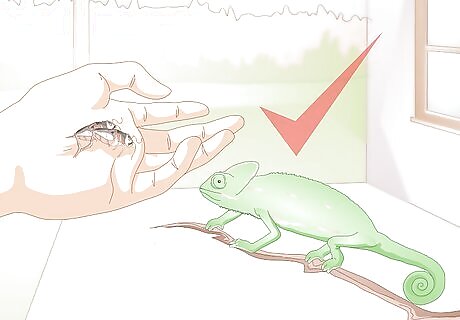
Select crickets to feed your chameleon. From your live crickets, you should measure out the proper size and number to feed your chameleon. This can vary based on your chameleon’s age, size, gender, and species. In general, you should not feed your chameleon a cricket that is any larger than the width of their head. Chameleons up to three months should be given as many small crickets as they can eat. They may also enjoy fruit and house flies. Veiled and Panther Chameleons: Chameleons up to six months old should eat between ten and twelve crickets a day. Between six and twelve months, they should have ten to twelve crickets every other day. Adults over a year old should eat between seven and ten large crickets every other day. Jackson’s Chameleons: Chameleons up to six months should eat between ten and twelve small crickets a day. Between six and twelve months, they should eat between eight and ten medium crickets every other day. Adults should eat between six and eight medium to large crickets every other day. Pygmy Chameleons: Between three and six months, they should have between six and ten small crickets daily. After six months, they should have between four and six crickets every other day. Flapneck, Graceful and Senegal Chameleons: Between three and six months, they should be given ten to twelve small crickets daily. Juveniles between six and twelve months should eat ten to twelve medium crickets every other day. Adults need five to seven small to medium crickets every other day.
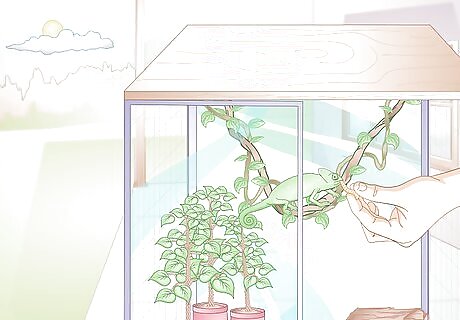
Feed in the morning. Feeding your chameleon early in the day can help them digest their food properly. Find a good, consistent schedule to feed your chameleons that works with your daily life. Remember that you will have to gut load the insects a few hours before you feed the chameleon. You may want to keep track of your feedings with a planner, calendar, or schedule. Check off dates that you fed the chameleon to make sure that they are fed the proper amount at the right times.
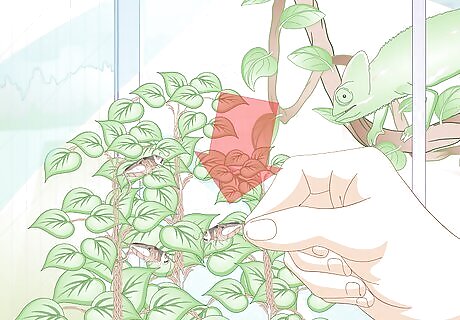
Place a few insects in the leaves and branches. If you do not have leaves or branches in your habitat, you can place them on rocks, furniture, or other items in the cage. You may place these relatively near to the chameleon. Remember to close the enclosure afterwards. The chameleon should see the insects moving and will slowly move towards them. You may want to watch your chameleon to make sure he notices the insects and that he is feeding on them. Do not leave too many live crickets in the cage at once. Some insects are aggressive and may bite your chameleon at night. Check under the rocks, plants, and other objects in the cage to make sure that there are no crickets hiding.
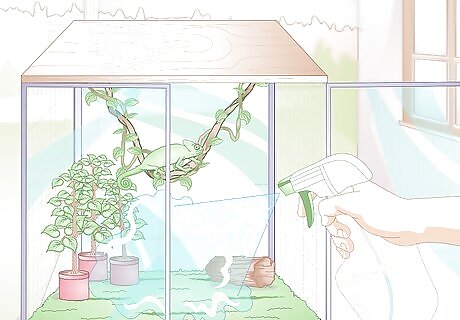
Mist the chameleon’s cage. Your chameleon will drink water off the plants and objects in their habitat. Using a spray bottle, mist the cage twice a day. You can also attach a dropper to the top of the cage, but you should make sure that the water falls onto plants in the cage so that your chameleon will know to drink it. Chameleons will not drink out of a bowl.
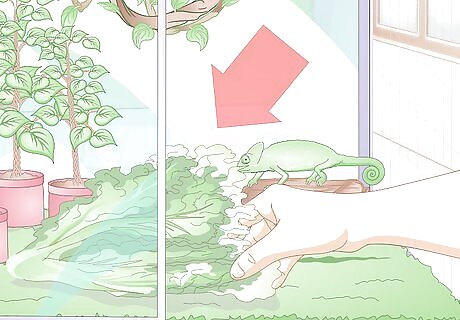
Give them leafy greens. While most chameleons will be happy eating a varied diet of insects, some do enjoy the occasional plant. You can try giving them mustard or collard greens. Mist the leaves with water, and watch to see if your chameleon eats them. Some chameleons will even eat fruit. You can cut up a small slice of mango or apple, and place it in their cage. Do not be worried if they do not eat it. It just means that your chameleon does not want fruit.
Giving the Chameleon Food Using a Cup
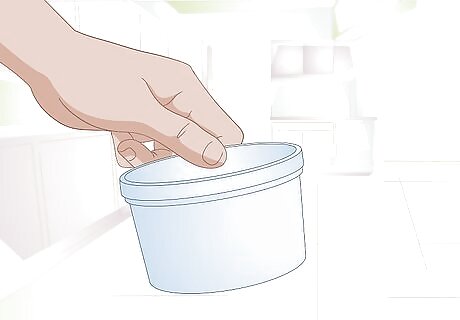
Find a proper cup. Any kind of plastic cup can help you feed your chameleon. The sides should be tall enough to prevent the insects from escaping. You should use a cup that has opaque sides. If you use a clear cup, the chameleon may not realize that it is there, and they may injure themselves trying to reach the insects. You may have success with an eight ounce cup. Some recommend that you use a cup as large as sixteen or twenty-four ounces.

Place the insects in the cup. Place the proper amount of crickets or other insects inside the cup before you place it in the cage. If you desire, you can dust them in their vitamin or mineral supplement while they are in the cup.
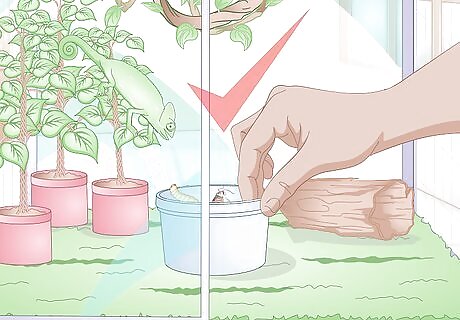
Put the cup in the cage. Chameleons will likely come at the cup from above, so it is good to make sure that the cup is placed low in the cage. You may even put it on a low-lying branch. Your chameleon may learn over time that their food appears in the cup, and you may even notice them hanging out near the cup when it is time to eat. You can also punch holes in the cup, and hang it from a plant in the cage. Make sure that you use the same feeding cup for each chameleon. Do not mix the cups, or you risk spreading germs between cages.


















Comments
0 comment